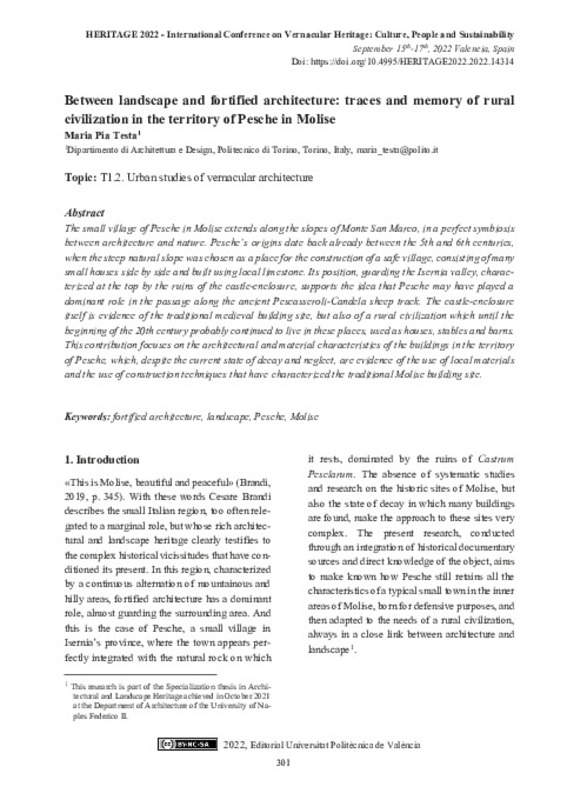JavaScript is disabled for your browser. Some features of this site may not work without it.
Buscar en RiuNet
Listar
Mi cuenta
Estadísticas
Ayuda RiuNet
Admin. UPV
Between landscape and fortified architecture: traces and memory of rural civilization in the territory of Pesche in Molise
Mostrar el registro sencillo del ítem
Ficheros en el ítem
| dc.contributor.author | Testa, Maria Pia
|
es_ES |
| dc.coverage.spatial | east=14.2766623; north=41.6056574; name=Pesche IS, Itàlia | es_ES |
| dc.date.accessioned | 2022-11-02T12:48:29Z | |
| dc.date.available | 2022-11-02T12:48:29Z | |
| dc.date.issued | 2022-09-13 | |
| dc.identifier.isbn | 9788413960203 | |
| dc.identifier.uri | http://hdl.handle.net/10251/189004 | |
| dc.description.abstract | [EN] The small village of Pesche in Molise extends along the slopes of Monte San Marco, in a perfect symbiosis between architecture and nature. Pesche’s origins date back already between the 5th and 6th century, when the steep natural slope was chosen as a place for the construction of a safe village, consisting of many small houses side by side and built using local limestone. Its position, guarding the Isernia valley, characterized at the top by the ruins of the castle-enclosure, supports the idea that Pesche may have played a dominant role in the passage along the ancient Pescasseroli-Candela sheep track. The castle-enclosure itself is evidence of the traditional medieval building site, but also of a rural civilization which until the beginning of the 20th century probably continued to live in these places, used as houses, stables and barns. This contribution focuses on the architectural and material characteristics of the buildings in the territory of Pesche, which, despite the current state of decay and neglect, are evidence of the use of local materials and the use of construction techniques that have characterized the traditional Molise building site. | es_ES |
| dc.format.extent | 8 | es_ES |
| dc.language | Inglés | es_ES |
| dc.publisher | Editorial Universitat Politècnica de València | es_ES |
| dc.relation.ispartof | Proceedings HERITAGE 2022 - International Conference on Vernacular Heritage: Culture, People and Sustainability | |
| dc.rights | Reconocimiento - No comercial - Compartir igual (by-nc-sa) | es_ES |
| dc.subject | Fortified architecture | es_ES |
| dc.subject | Landscape | es_ES |
| dc.subject | Pesche | es_ES |
| dc.subject | Molise | es_ES |
| dc.title | Between landscape and fortified architecture: traces and memory of rural civilization in the territory of Pesche in Molise | es_ES |
| dc.type | Capítulo de libro | es_ES |
| dc.type | Comunicación en congreso | es_ES |
| dc.identifier.doi | 10.4995/HERITAGE2022.2022.14314 | |
| dc.rights.accessRights | Abierto | es_ES |
| dc.description.bibliographicCitation | Testa, MP. (2022). Between landscape and fortified architecture: traces and memory of rural civilization in the territory of Pesche in Molise. En Proceedings HERITAGE 2022 - International Conference on Vernacular Heritage: Culture, People and Sustainability. Editorial Universitat Politècnica de València. 301-308. https://doi.org/10.4995/HERITAGE2022.2022.14314 | es_ES |
| dc.description.accrualMethod | OCS | es_ES |
| dc.relation.conferencename | HERITAGE2022 International Conference on Vernacular Heritage: Culture, People and Sustainability | es_ES |
| dc.relation.conferencedate | Septiembre 15-17, 2022 | es_ES |
| dc.relation.conferenceplace | Valencia, España | es_ES |
| dc.relation.publisherversion | http://ocs.editorial.upv.es/index.php/HERITAGE/HERITAGE2022/paper/view/14314 | es_ES |
| dc.description.upvformatpinicio | 301 | es_ES |
| dc.description.upvformatpfin | 308 | es_ES |
| dc.type.version | info:eu-repo/semantics/publishedVersion | es_ES |
| dc.relation.pasarela | OCS\14314 | es_ES |








